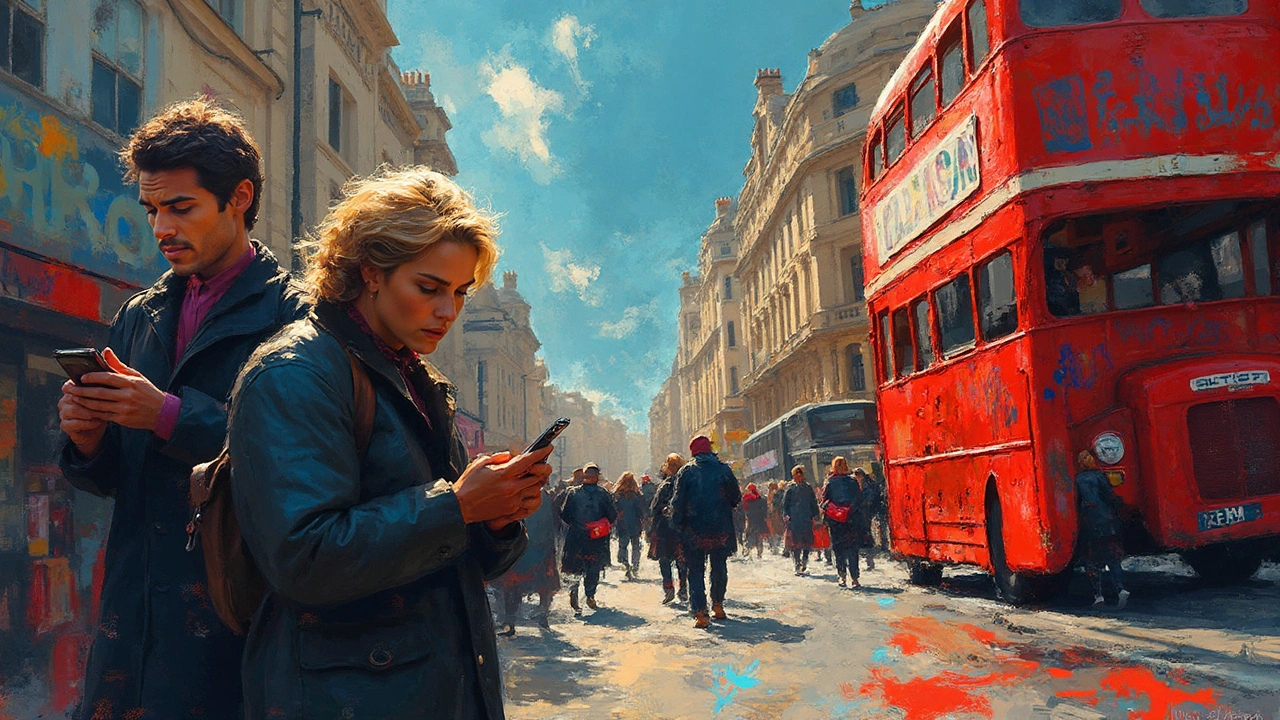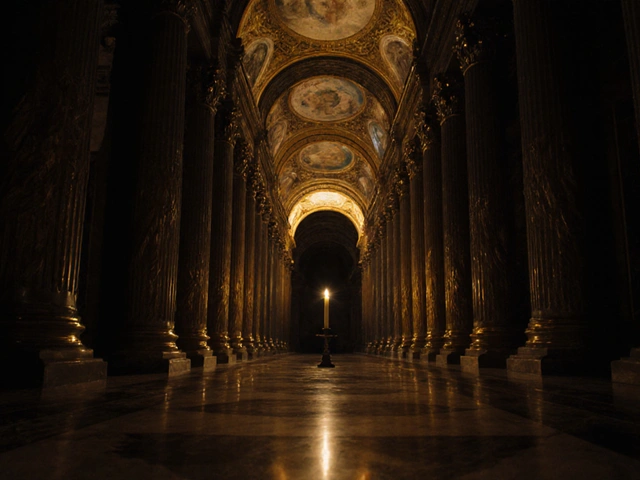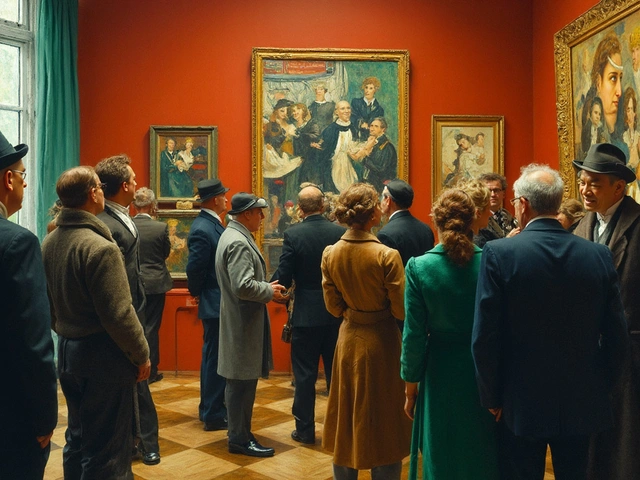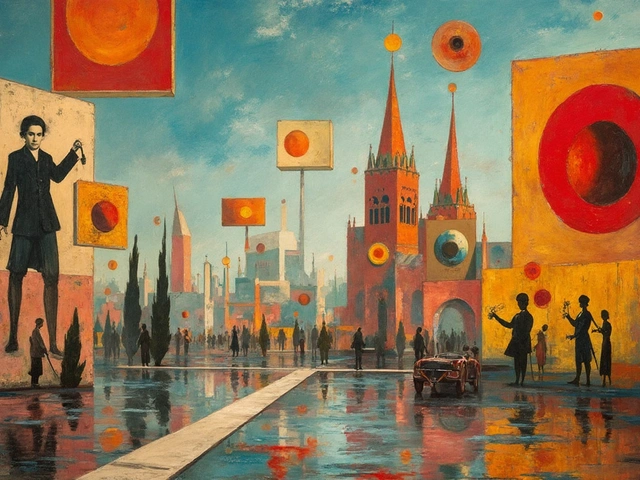Ever feel like the world’s moving too fast for you to actually process what you’re feeling? That’s exactly where expressionism steps in—cutting straight to the weird, messy emotions nobody wants to admit out loud. It isn’t a fancy museum thing anymore; it’s all over your phone, your feeds, even in the music you hear in coffee shops.
Expressionism is all about raw, honest emotion. What does that even look like? Think bold colors, jagged lines, faces that look a bit too real—and at the same time, totally not like real life at all. No need to guess what the artist feels; it’s pretty much yelling at you from the canvas (or the screen).
This kind of art is powerful because it admits that life gets weird, angry, or even flat-out ugly sometimes. But here’s the kicker: the more you see expressionism around you, the more you realize everyone’s in the same messy boat. Even if you’re not an artist, knowing how to spot or use this style can help you make sense of your own head—and maybe express stuff that’s hard to put into words.
- Expressionism 101: What’s the Deal?
- Why Expressionism Won’t Quit in Modern Times
- Where You’ll Spot Expressionism Today
- How It Shapes Our Emotional World
- Expressionism in Tech and Social Media
- Tips to Use Expressionism in Your Own Life
Expressionism 101: What’s the Deal?
Expressionism is basically the rebel of the art world. It popped up in the early 1900s, mainly in Germany, as a way to ditch the old rulebook and let artists do something wild—show what they actually feel inside. Instead of making stuff look super realistic, expressionist artists cranked up the emotion using color, shape, and straight-up weirdness. Famous painters like Edvard Munch (the guy behind "The Scream") and Wassily Kandinsky ditched calm landscapes for raw feelings smeared across canvas.
If you’re wondering exactly when this blew up, check out the years 1905 to 1930. Big groups like Die Brücke ("The Bridge") in Dresden and Der Blaue Reiter ("The Blue Rider") in Munich pushed the movement hard. They weren’t looking for beauty—they wanted honesty, sometimes even rage or anxiety, in art. Some expressionist works have jagged lines, intense colors, and faces that can look flat-out disturbing. It’s all about cranking up what’s going on emotionally, not just painting what you see.
Expressionism didn’t stop at painting either. It hit theater, film, poetry, and even architecture. Ever seen the old movie "The Cabinet of Dr. Caligari?" That’s expressionism on film—with twisted, shadowy sets and super dramatic acting to hit you right in the gut.
Here’s a quick overview of where and when the big moments happened:
| Year/Period | What Happened |
|---|---|
| 1905 | Die Brücke group formed in Dresden |
| 1911 | Der Blaue Reiter started in Munich |
| 1910s–1930s | Expressionism spread to theater and film |
| 1920 | "The Cabinet of Dr. Caligari" released |
Why should you care now? Because expressionism made it okay to put feelings front and center. That idea still shapes everything from emoji-filled texts to intense TikTok videos. Once you know what to look for—distorted shapes, bold colors, zero interest in perfection—you’ll see it all over the place. It’s basically the backbone of how we show raw emotion in art and media today.
Why Expressionism Won’t Quit in Modern Times
The world’s gotten crazy fast and kind of unpredictable. That’s why expressionism isn’t going anywhere; people are hungry for art that doesn’t try to look perfect. You don’t need a fine arts degree to know that something raw and emotional grabs your attention way faster than another photorealistic landscape. Our brains just react stronger to stuff that feels real—even if it’s messy.
Want proof? When social media exploded, so did a wave of homemade art styles full of rough outlines, wild colors, and exaggerated moods. Instagram, TikTok, and even video games use expressionist tricks every day. Creators love mashing together color and attitude to make their messages stick—a method straight out of the expressionist playbook from over a century ago.
| Area | Modern Expressionism Example | Reach/Impact Estimate |
|---|---|---|
| Social Media Art | Memes, digital illustrations | 1+ billion daily users exposed |
| Film/TV | The Batman (2022), Joker (2019) | Hundreds of millions worldwide |
| Fashion | Bold prints, mixed textures | Featured in top brands' collections |
Another reason expressionism always bounces back? Mental health is finally getting serious attention. People are spotting anxiety or sadness in bold brushstrokes long before they read a caption. Art therapists say expressionist techniques help clients open up, since showing emotion feels safer than talking about it.
- Expressionism bypasses the need to explain or defend your feelings—art speaks first.
- This style fits both traditional painting and quick digital sketches, so anyone can try it.
- It helps build empathy—seeing someone else’s emotional truth can change how you think about your own or others’ struggles.
The expressionism wave keeps spreading because emotions themselves never go out of style. Every new generation finds ways to visually shout, soothe, or vent in public through art. That’s why you’ll keep running into it, on screens, in galleries, and even in your group chats.
Where You’ll Spot Expressionism Today
If you think expressionism is just about old paintings and moody museums, think again. It’s popped up almost everywhere you look. Movie posters? Total expressionist vibes. Music videos shooting for pure, gut-level feelings? You’re looking at modern expressionism doing its thing.
Let’s break it down. Netflix’s hit series "Euphoria" uses wild lighting and twisted close-ups to show how the characters really feel inside. The video game "Life is Strange" leans on distorted visuals and colors to jerk your emotions around. Even brands, like Nike, use edgy, emotional artwork on sneakers and ads to connect deeper with fans.
Online, the meme world is also overflowing with expressionist energy. Faces are stretched, reactions are amped up, colors are wild—just to get across how someone feels. Scroll through Instagram’s art scene and you’ll spot posts looking way more like emotion bombs than classic portraits.
“Expressionism isn’t just about art history—it’s the heart of how we show the raw, unfiltered parts of ourselves. It shows up in everything from street murals to viral YouTube edits.” — Dr. Maya Valenzuela, art and digital culture researcher
Here’s a quick look at some real-world places where modern expressionism lives and breathes:
- Street art and murals in cities like Berlin, New York, and Sao Paulo
- Album covers for artists like Billie Eilish and Kendrick Lamar
- Digital GIFs and stickers for messaging apps
- Ad campaigns from brands wanting to stand out emotionally
- Short films and indie documentaries focusing on mental health
Want some numbers to prove it’s everywhere? Check out this quick table:
| Medium | % Citing Expressionist Influence (2024 Survey) | Where You’ll See It |
|---|---|---|
| Music Videos | 47% | Visual styles, set design |
| Street Art | 65% | Urban murals, graffiti |
| Ad Campaigns | 32% | Bold, emotional messages |
| Video Games | 28% | Graphics, storytelling |
If you’re looking for expressionism, you won’t have to squint or search hard—it’s slipped into daily life, making sure things feel real, wild, and way more human than just ‘pretty pictures’ ever could.
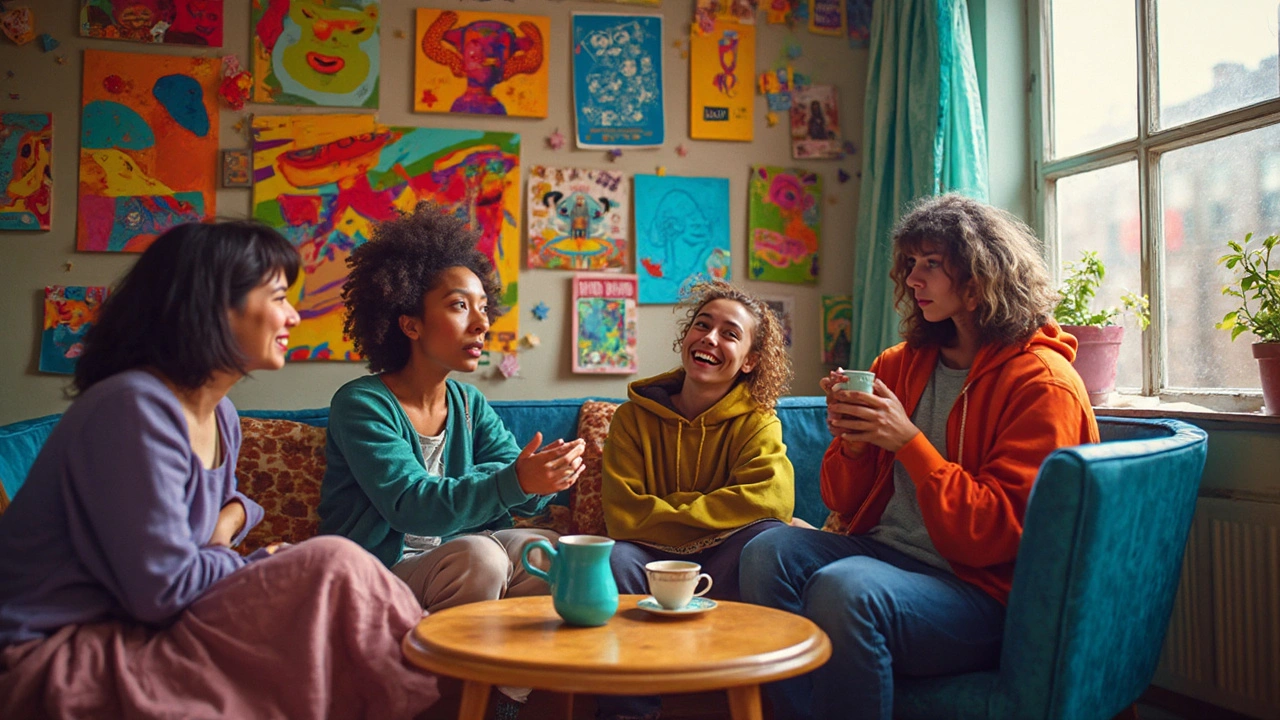
How It Shapes Our Emotional World
Expressionism has this wild way of turning feelings into something visual, which makes it super relatable in an age when everyone’s overwhelmed by info and constant scrolling. One key fact: in a 2020 survey by the British Psychological Society, people looking at expressionist paintings reported stronger emotional reactions compared to more realistic art. It seems that when art gets a little unfiltered, it hits home harder.
So why is that? Expressionism works because it throws perfection out the window. Instead of pretty scenes or photorealistic faces, it uses wild lines, huge gestures, and unfiltered colors to talk about anxiety, anger, joy—the big stuff we don’t always know how to share. This direct approach helps people feel seen, especially if they’re dealing with things like stress or isolation. No wonder expressionist styles are huge in art therapy. Therapists often pick these works to get people comfortable with opening up, since seeing honest emotion on canvas makes it easier to admit your own.
Expressionism doesn’t just affect those looking at art—it’s also a powerful tool for creators. Whether someone’s painting, drawing, or even designing memes, letting emotion take the lead can reduce bottled-up stress. According to a Stanford study from 2023, adults who spent thirty minutes a week making art in an expressionist style had noticeably lower anxiety after a month compared to those doing more planned, technical work.
It also shapes the way whole groups vibe with each other. When a community creates art together—like those messy city murals or expressive public sculptures—it’s an open shout: “We’re all feeling this!” That shared experience helps people connect in ways simple chat never could. So when you see those colorful, intense murals on a city wall, it’s not just decoration; it’s emotional glue holding people together.
Bottom line: expressionism is like an emotional shortcut. It lets us put into colors and shapes what we can’t easily say. In a world where being open about feelings still feels kind of risky, having art that gets real is more helpful than ever.
Expressionism in Tech and Social Media
You might not think of your Instagram or TikTok feed as a gallery, but it’s loaded with expressionist vibes—just in a digital package. Artists now use tablets and styluses instead of paint, and they reach millions of people with a single share instead of an art opening. Filters, glitch effects, wild color palettes, and face morphs are everywhere, letting anyone warp images to match their mood. That raw, messy honesty at the heart of expressionism fits right in with the unfiltered posts and creative edits popping up every day.
Take a look at trending memes or viral stories. They get big because they hit people where it hurts, or where it counts—big feelings, clear reactions, no hiding. Expressionism thrives online because it cuts through the polished, perfect feeds and shows what’s really going on inside. You’ll see this in:
- Photo editing apps like VSCO or Prisma, helping users create distorted, mood-heavy images
- AI-generated art on platforms like Midjourney, turning rough sketches or ideas into untamed visuals full of drama
- Emoji-packed stories and digital collages, where everything’s exaggerated for effect
It’s not just about flexing creativity—expressionist digital art is used in marketing as well. Some brands skip perfectly staged photos and go for chaotic, emotional images to connect with younger audiences. TikTok creators often latch onto these trends, going viral with content that looks raw and feels real rather than staged.
Here’s an interesting stat: According to a 2024 survey by Statista, almost 72% of Gen Z users said they prefer content on social media that feels authentic and emotional over content that looks polished and traditional. This pretty much nails down why digital expressionism is everywhere—it’s what people relate to in an online world drowning in generic posts.
| Platform | Popular Expressionist Tool/Trend | Main Age Group |
|---|---|---|
| Photo filters, moody edits, reels with emotional music | 18-34 | |
| Midjourney/AI Art | AI-powered surreal and emotional artwork | 20-40 |
| TikTok | Storytelling, face morphs, vivid effects | 16-30 |
If you want to try it yourself, start with apps that let you mess around with color, lighting, or shape. Don’t be afraid to break the rules—expressionism is all about getting real with your feelings, not chasing perfection.
Tips to Use Expressionism in Your Own Life
You don't need an art degree to bring expressionism into your routine. The best part about this style is that it's less about “getting it right” and more about being honest. Here’s how to squeeze some of that raw energy into your daily grind:
- Journal with Feelings, Not Filters: Next time you write, skip the diary “dear journal” stuff. Just scribble what’s actually going on inside—frustration, excitement, confusion—without editing yourself. Some famous expressionist artists, like Edvard Munch, kept raw, emotional notes that helped shape their most famous pieces.
- Make Messy Art: Grab some cheap paints or even a sketch app on your phone. Don’t try to draw perfectly. Use wild colors, sharp lines, or smudges to show what you’re feeling. Art therapy studies suggest expressive painting can cut anxiety by up to 40% after just one session.
- Try Sound Expressionism: This isn’t just a visual thing. Sing, shout, or play messy music. Studies from the American Music Therapy Association show that tuning into emotional music (even if it gets loud or wild) helps lower stress hormones.
- Dress to Express: Your clothes can be a mini-expressionist canvas. Pick out stuff that fits your mood—bright, clashing, dark, or bold. According to a 2022 survey by Fashion Psychology Institute, 63% of people felt more confident wearing colors that matched their inner mood, even if they clashed.
- Start a Group Session: Expressionism goes beyond the solo act. Grab friends and do a messy art night or emotional playlist swap. Group workshops in expressive art have become popular in therapy circles, especially for helping folks share tough feelings.
Here’s a quick look at how expressionist habits help:
| Expressionist Habit | Reported Benefit | Source / Data |
|---|---|---|
| Expressive Painting | Reduces anxiety by 40% | 2018 Art Therapy Journal |
| Listening to Emotional Music | Lowers stress hormones for 30 mins | American Music Therapy Assoc. |
| Wearing Mood-Matching Colors | Boosts confidence in 63% of users | Fashion Psychology Institute, 2022 survey |
Expressionism isn't about being perfect—it's about being real. Try these ideas, see what sticks, and don’t worry about the mess. That’s kind of the point.

